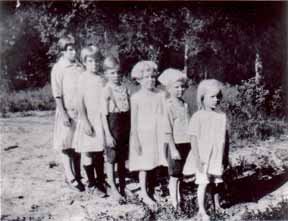 |
| 1910: Edith Hall before she married John Stone. |
While casually googling my maternal great-grandparents, I discovered a 1912 legal suit they brought against Canadian Northern Railway for a locomotive-caused forest fire that destroyed part of their northern Minnesota properties in 1910. They lived on homesteads near Williams, Minnesota, and they were clearing the land for cultivation, selling the timber to the sawmill at Rainy River, or to the related industries like box-makers, toothpick-makers, and paper mills.
 |
| 1910: John Stone as a single man. |
The spring and summer of that year were extremely dry, and hotter than any year they could remember. There was a drought that made forests and prairies, after abundant winter snows, into fuel ready for any spark of locomotive cinders, lightning, or even glass or metal lying in the grass. The foresters stripped the branches off limbs and trunks and littered the ground with them, creating even more quick, hot fuel for a firestorm. (The heat and drought, combined with poor agricultural practices, also made a dust bowl of the prairies, that was a precursor of the more-famous dust bowl of the 1930s.) A great fire in Washington-Idaho-Montana had also raged that summer.
 |
| Canadian Northern locomotive and coal car from 1910. |
In the Minnesota inferno, there may have been as many as four fires that merged into a single conflagration that burned for miles and destroyed 400,000 acres. Between 29 and 42 people were killed.
My great-grandparents and their neighbors won the suit, as the court ruled that the locomotive cinder or spark was the cause. Edith was able to prove that her lost timber, still standing as live forest until the fire, was more valuable than cut scrubby stuff that was laying around to be carted away or burned as fuel. She got more money. John Stone was awarded $265 and Edith Hall was awarded $525. The rail company appealed, but the judge upheld the original ruling.
Take that, Canucks, eh? That's $790 (1912 value) you'll never see again! In 2016 dollars, the value would be $18,842.
In addition to the awards, my great-grands got court costs. They were still single at the time of the fire, but they married on November 10, 1910, in Winnepeg, Manitoba, and their firstborn, my grandmother, was born in 1914. From what I've seen in photos, they lived a frugal, homestead sort of life, with summer gardens, lake fish and forest meat, and I can't imagine what they did with the settlement money.
The Stones had four single births and one twin birth, and their children, 1925-ish, posed for a photo in a stairstep formation. My second cousin, a granddaughter of Helen, says, "I recall a story about such fires that happened up there, though it had to be after John and Edith married. The story was of surviving such a fire by soaking mattresses in the creek and then getting in the creek and under the wet mattresses as the fire passed by. I don't have any facts, though, just the story." I heard the same story on my branch of the family. That may have been sometime between 1918 and 1928, as our grandmothers were old enough to remember the fire and how they survived the burnover.
 |
| 1924-25: Lois (my grandmother), Helen, John, Ruby, and the twins Russell and Ruth. |
I read on Wikipedia that the Spooner-Baudette Fire of 1910, which burned Williams where the Halls and Stones lived, was the third-worst fire in Minnesota history, and "...For this reason, the 1910 Baudette Burn is considered one of the most significant wildfires in Minnesota history. As a direct result of this catastrophe, funds were approved by the legislature to establish the Minnesota Forestry Service (later the DNR) with its system of forest rangers and forestry districts." How fascinating that Edith's and John's grandson, my uncle Lloyd, was a DNR ranger for his entire career, in the Minnesota-Canada border region.
 |
| 1930: My great-grandparents, Edith Mae Hall (b. 1891) and John Stone (b. 1880). Notice the puff of smoke in the distance! |
Christy K Robinson is the author of five-star nonfiction and fiction historical books, as well as author of Rooting for Ancestors and William and Mary Barrett Dyer websites. You will find her books at http://bit.ly/RobinsonAuthor.
·
We
Shall Be Changed (2010)
· Mary Dyer Illuminated (2013)
· Mary Dyer: For Such a Time as This (2014)
· The Dyers of London, Boston, & Newport (2014)
· Effigy Hunter (2015)
· Anne Marbury Hutchinson: American Founding Mother (2018)
· Mary Dyer Illuminated (2013)
· Mary Dyer: For Such a Time as This (2014)
· The Dyers of London, Boston, & Newport (2014)
· Effigy Hunter (2015)
· Anne Marbury Hutchinson: American Founding Mother (2018)

